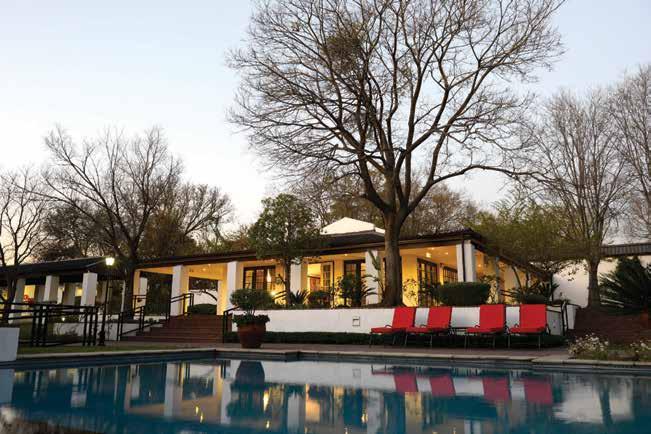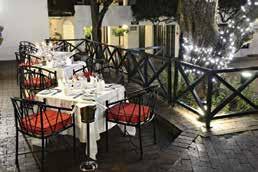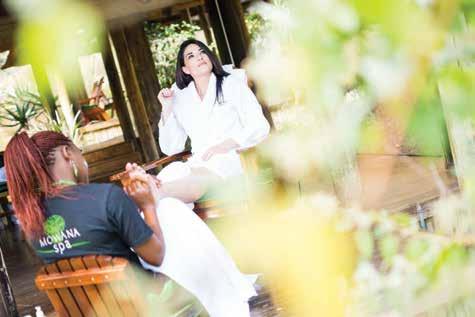
10 minute read
Tourism and events
The events and conferences sector is growing across the country.
South Africa gained its 10th World Heritage Site in 2018, opening up the possibility of a new type of niche tourism for the country and Mpumalanga in particular.
A three-billion-year-old micro-fossil found in the Makhonjwa Mountains near Barberton and the border with Swaziland is thought to be the oldest sign of life on the planet. Now the Makhonjwa Mountains, themselves somewhere between 3.2-billion and 3.6-billion years old, have been declared a World Heritage Site by the United Nations Educational‚ Scientific and Cultural Organisation (UNESCO). The tourist offering near Barberton has been branded the Genesis route.
There are 711 745 people employed in the tourism industry, with road transport (29%), food and beverages (20%) and accommodation (19%) absorbing the largest numbers. The sector contributes 9% to South Africa’s gross domestic product (GDP) and the National Department of Tourism has ambitious growth targets. It wants to see tourism contribute R1-trillion to GDP and create an additional 300 000 jobs by 2026.
Tourist numbers are going up, both from traditional markets and from newer markets like China and India. In 2017, South Africa hosted 10.2-million tourists. This represented a small increase of just 2% over the previous year, but that figure was a 10% improvement on the year before.
The rise in tourist numbers follows determined efforts by national and provincial tourism bodies to promote the country. In Mpumalanga, links to BRICS
SECTOR INSIGHT
A new World Heritage Site has been declared in Mpumalanga. • The Cape Town International Convention Centre (pictured) has increased capacity and flexibility.
countries have yielded results and in KwaZulu-Natal there has been a strong focus on the meetings, incentives, conference and exhibition sector (MICE).
A Western Cape project to increase the number of seats on routes to and from Cape Town called Cape Town Air Access has been spectacularly successful. Cape Town International Airport’s capacity has increased by more than 600 000 seats in the two years that the programme has been running.
The Port of Cape Town has launched its dedicated cruiseship terminal, and the area between the terminal and the Cape Town International Convention Centre is being developed. The precinct, called the Yacht Club, includes a hotel, residential and commercial complex owned by the Amdec Group, and is linked to the Waterfront via an extension of the existing canal.
In Durban, a joint venture between MSA Cruises SA and Africa Armada Consortium will spend R175-million on the financing‚ construction‚ maintenance and operation of a cruise terminal for a 25-year concession period. The terminal should be operational in October 2019.
A lot of effort has gone into increasing the number of South Africans who take trips within the country. A Tourism Incentive Programme (TIP) has been launched by the National Department of Tourism. Tourism has been earmarked as one of the six key growth sectors in national government’s New Growth Path.
The Industrial Development Corporation has committed to investing R2-billion in local resorts (and in the African hotel market). There are several unused or under-used facilities. One suggestion is that former military bases could be converted into low-fee resorts. Other possible niche sectors include astrology and adventure tourism.
An Enterprise Development Project Management Unit (PMU) has been established. Among the PMU’s tasks will be to manage an Enterprise Development Online Information Portal for SMMEs.
South Africa’s tourism offering is incredibly diverse. Superb natural beauty, excellent beaches (45 have Blue Flag status), incomparable wildlife, vibrant cities and cultural and heritage attractions that represent a heterogeneous population and a dramatic history, South Africa has it all. Every province has superb natural assets. In the Northern Cape these include wonderful spring flower displays, spectacular arid areas and brilliantly clear night skies for sky-gazers. There are no fewer than six national parks and five provincial reserves in the province, each showing off distinct geographical and biological features.
Culture and heritage accounts for 40% of world tourism and is one of the fastest-growing sub-sectors. The other nine UNESCO World Heritage Sites in South Africa are: Robben Island Museum, Cradle of Humankind, Mapungubwe Cultural Landscape, iSimangaliso Wetland Park, uKhahlamba Drakensberg (newly named Maloti Drakensberg Transfrontier Park), Richtersveld, Cape Floral Kingdom, Khomani Cultural Landscape and Vredefort Dome.
Popular history or cultural sites include the Nelson Mandela Museum, Hector Petersen Memorial, Apartheid Museum, Freedom Park, Voortrekker Monument, Constitution Hill, District Six Museum and the Bo-Kaap Museum. There are opportunities to further develop the full potential of tourism at heritage sites.
Events
A total of 34 000 international delegates attended conferences in Cape Town in 2017, helping to secure the city’s number one spot in Africa for the 10th year in a row for the African city hosting the most international association meetings. The ranking is awarded by the International Congress and Convention Association (ICCA).
The Cape Town and the Western Cape Convention Bureau, a Wesgro unit, promotes the Cape as a venue and assists with bids, planning support and on-site services. In the first quarter of 2018, nine bids were won with an estimated economic impact of R336million and attendance of more than 9 000 delegates.
The annual AfriCom event, hosted by the CTICC, regularly attracts up to 14 000 visitors who can choose from 400 exhibits and 450 speakers in the fields of telecoms, media and technology.
The R900-million expansion of the Cape Town International Convention Centre (CTICC2,) has given the city’s biggest venue additional volume and flexibility. The new section of the centre hosted its first conference in September 2017, the 21st Annual Congress of the South African Council of Shopping Centres (SACSC) at the same time as the CTICC was hosting another major conference.
Johannesburg and Durban are the other two South African cities with large MICE sectors, but towns linked to research universities (like Potchefstroom and Stellenbosch) and game and nature reserves are also popular destinations for conferences. Most hotels have conference facilities.
Sun City in the North West has a wide range of venues and has recently won bids to host big events such as the SAFTAS, the South African Film and Television Awards.
A new event on Limpopo’s calendar caused great excitement in 2018 with the first riding of the Tour de Limpopo, a four-day cycling event.
Structure of the industry
The South African tourism industry is well segmented. The distribution channel is dominated by four major groups, each of which runs several companies in different parts of the value chain. The biggest groups are: • Imperial Holdings: mostly logistics, companies include Europcar and Tempest Car Hire. • Bidvest Travel and Aviation: Budget Rent a Car, Bidvest Sky Lounge,
Rennies Foreign Exchange, BidTravel, Harvey World Travel, HRG
Rennies Travel and BidAir Services. • Cullinan Holdings: iKapa Tours and Travel, Thompsons, Hylton Ross
Tours, Pentravel, Grosvenor Tours and Springbok Atlas. • Tourvest: The group controls 63 companies dealing with many aspects of the tourist experience: tour operators and conference organisers, foreign exchange, retail (gift shops and duty-free shops) and hotels (African Hotels and Adventures).
Casinos are a popular part of many entertainment and accommodation complexes around the country, although relatively few licences are in operation. Private game reserves and golf resorts has been one of the fastestgrowing markets in recent years. The South African Golf Tourism Association says that up to 10% of visitors to the country are attracted by its golf courses.
The Garden Route and the KwaZulu-Natal coastline are rich in golfing venues. Between George and Cape St Francis there are many highlyrated golf courses including Pinnacle Point, Fancourt (three courses), Simola, Plettenberg Bay Country Club and St Francis Links. Limpopo has two highend golf resorts fairly near Johannesburg: Zebula Golf Estate and Spa and the Legend Golf and Safari Resort which has the world’s most dramatic golf hole, a par-three where golfers are ferried to the top of a mountain by helicopter and take aim at an Africa-shaped green at the bottom of the mountain.
Wine tourism contributes indirectly more than R4.5billion to the South African tourism sector (South African Wine Industry Information and Systems, SAWIS). According to Wine Tourism South Africa, a website and publishing concern that provides information about the wine industry, 43% of visitors to South Africa visit the Cape Winelands.
ONLINE RESOURCES
African Business Travel Association: www.abta.co.za South African Golf Tourism Association: www.sagta.co.za South African National Parks: www.sanparks.co.za South African Tourism: www.southafrica.net South African Tourism Services: www.satsa.com

INDABA HOTEL, SPA & CONFERENCE CENTRE
YOUR AFRICAN DESTINATION IN JOHANNESBURG
Just north of the fast paced business world of Sandton in the upmarket residential suburb of Fourways, lies the 258 bedroom Indaba Hotel, Spa & Conference Centre. It is a compelling blend of business-like convenience and efficiency, with a relaxed and warm country atmosphere.
Coupled with easy and convenient access to all main highways, OR Tambo International Airport and a mere 15km from Lanseria International Airport, the hotel features an impressive selection of some 24 multi-purpose conference venues that can accommodate up to 2 000 delegates in total with banqueting facilities for up to 500 guests.
With two restaurants on property, there is no need to leave the comfort of the hotel to enjoy world class cuisine. Our 300 seater Chief’s Boma Restaurant caters for all tasted with over 120 African inspired dished ranging from North African Moroccan cuisine to Koeksisters and Melktert from the cape – and with a “Shisa Nyama” grill boasting a variety of game meats sizzled to your specification, everyone is sure to find their favourite.
Well known for the lavish full South African Breakfast Buffet, the Epsom Terrace Restaurant also boasts an evening Bistro Menu which will delight even the most demanding gourmet’s exacting standards. A traditional Carvery Lunch with live music can be enjoyed every Sunday with limited outdoor seating available for those who prefer dining al fresco – after all, Jo’burg really has the best weather in South Africa.






Take a wander through the 17 hectares of lush bushveld gardens and you will find the Mowana Spa - a wellness sanctuary which will revive your senses, rejuvenate your body and soothe your soul. The Mowana Spa, which takes its name from the majestic Baobab Tree of African Lore and Legend, offers wellness journeys based on the recognized healing energy of Tribal Massaging.
Signature Pamper Journeys include the decadent Mowana Full Day African Rejuvenation Spa pamper which is an indulgent spa experience including breakfast, lunch, complimentary beverages and six revitalizing treatments; the romantic Mowana African Skies Night Spa pamper with includes dinner, complimentary beverages and 3 relaxing treatments; and the indulgent Mowana African Escape Spa & Stay Pamper Journey for the ultimate decadent relaxation.
Our commitment to service excellence and staff empowerment through training and mentoring will ensure that your needs are met and your expectations exceeded as you enjoy a Day of Pampering at Mowana Spa.
The Indaba Hotel and Mowana Spa are also PROUDLY GREEN ensuring responsible tourism and minimising carbon foot print through extensive recycling of waste products, water-wise gardening, greening conference initiatives, better material choices, minimising power usage and buying local - after all, a better place to live is a better place to visit.
The Indaba Hotel is sure to meet all your business and leisure requirements. We look forward to welcoming you to our oasis in the City.
15 MINUTES FROM SANDTON ... A MILLION MILES AWAY













